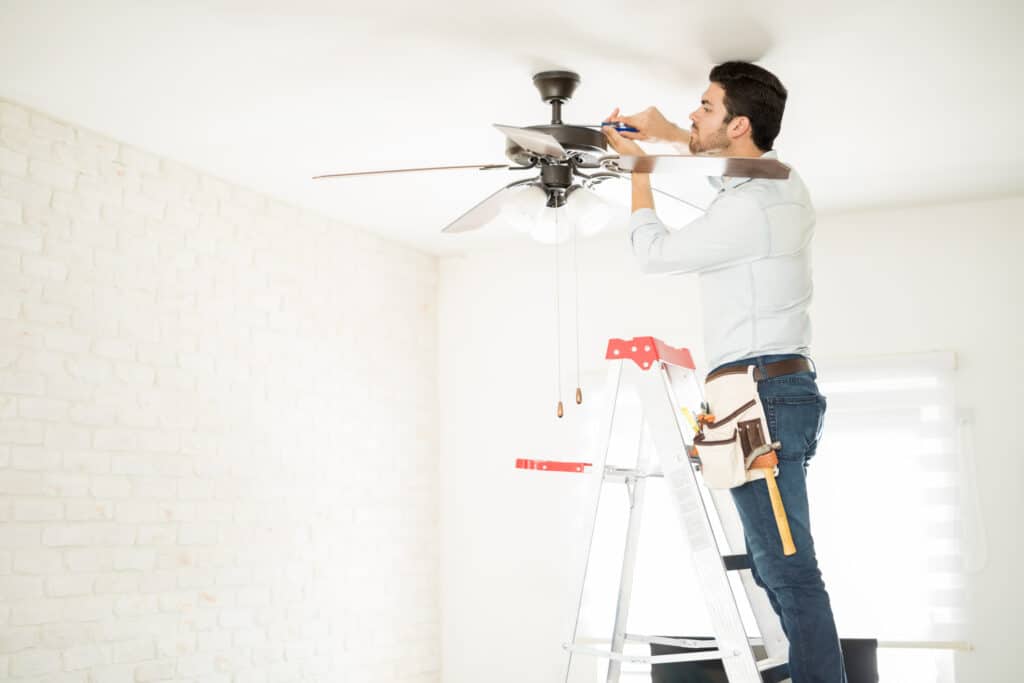How to Achieve Optimal Air Circulation with Ceiling Fans

Ceiling fans play a vital role in achieving optimal air circulation in your home, which is essential for maintaining comfort and air quality. Whether you reside in Florence, SC, or anywhere else, the strategic placement and proper use of ceiling fans can significantly enhance your living environment. These fans not only facilitate efficient air flow but also add aesthetic value to your rooms. Understanding how to select and utilize ceiling fans effectively can lead to improved air circulation and energy efficiency.
When considering the installation of ceiling fans, it’s important to select the right size and type for each room. A fan that is too small won’t adequately circulate air in a large room, while a fan that is too large could create an uncomfortable amount of airflow. Additionally, the style of the fan should complement the interior design of your home. This ensures that the ceiling fans are both functional and visually appealing.
The placement of ceiling fans is also crucial for optimal performance. Fans should be installed in the center of the room, ideally running with enough clearance from the ceiling to enhance air flow. In places like Quinby, SC, where temperatures can vary, having a ceiling fan that can operate in reverse is beneficial for circulating warm air during cooler months.
Moreover, understanding the settings and maintenance of your ceiling fans can greatly affect their efficiency and longevity. Regular cleaning of the fan blades is necessary to prevent dust accumulation that can hinder performance. By following these tips, you can ensure that your ceiling fans work effectively year-round, providing comfort and reducing energy costs.
Understanding the Basics of Ceiling Fans
To fully appreciate the benefits of ceiling fans, it’s crucial to grasp their basic mechanics and functions. Ceiling fans operate by using rotating blades to move air, creating a breeze that helps in cooling occupants through a wind-chill effect. In warmer months, this can make a room feel cooler without the need for lowering the thermostat. Moreover, in cooler weather, particularly in areas like Florence, SC, reversing the fan’s direction pushes warm air down from the ceiling to keep rooms comfortably warm.
The efficiency of ceiling fans is influenced by their design and features. Fans with more blades do not necessarily increase efficiency; instead, blade pitch and motor quality are more significant factors. A steeper blade pitch moves air more effectively, enhancing the fan’s ability to circulate air within a room. Additionally, energy-efficient motors can reduce electricity usage, which is beneficial for both the environment and your utility bills.
When selecting ceiling fans, consider the size of the room. A common guideline is to use a 36 to 44-inch diameter fan for smaller rooms and a 52-inch or larger fan for bigger rooms. This ensures that the fan can effectively circulate air throughout the entire space. For exceptionally large spaces, multiple fans might be necessary to achieve optimal air movement and coverage.
Lastly, the installation height of a ceiling fan impacts its performance and safety. The ideal height from the floor to the fan blades should be approximately 8 feet; this maximizes the fan’s efficiency and safety. In regions like Quinby, SC, ensuring proper installation can make a significant difference in your comfort and the overall effectiveness of your ceiling fans in maintaining pleasant indoor temperatures year-round.

Photo from iStock – Credit: Antonio_Diaz
Factors to Consider When Choosing Ceiling Fans
When choosing air circulation solutions for your home, several factors need to be considered to ensure they meet your needs effectively. First, think about the function of each room. Spaces that serve different purposes may require different types of equipment. For example, a quiet, low-speed unit might be ideal for a bedroom to minimize noise, while a high-speed model could be better suited for a busy kitchen area. Additionally, these devices can help manage the warmer climates of areas like Florence, SC, where maintaining a cool indoor environment is crucial.
Another important consideration is energy efficiency. Opting for models with Energy Star ratings can significantly reduce your power consumption. These options are designed to operate more efficiently, using less energy while still providing high air output. This not only helps in reducing your utility bills but also supports environmental conservation. Energy-efficient choices are particularly beneficial in places like Quinby, SC, where energy costs can add up due to the need for continuous indoor cooling and heating.
Aesthetics also play a crucial role in your selection process. Air circulation units come in a variety of styles, colors, and materials that can enhance or detract from your home’s decor. Whether you prefer a modern look with sleek lines and a minimalist design or a more traditional appearance with wood finishes and ornate details, the right option should complement your home’s style while being functional.
Finally, consider the control features. Modern systems offer a range of mechanisms, from pull chains to remote controls and even smart home integrations that allow for voice commands. These features provide convenience and flexibility in how you operate them. For instance, being able to adjust speed settings or turn the unit on and off from a smartphone can greatly enhance user experience, making it easier to maintain comfort in your home throughout the year.
The Role of Ceiling Fans in Air Circulation
Air circulation devices play a pivotal role in enhancing airflow within homes, making them indispensable for maintaining a comfortable living environment. By continuously moving air, these systems help evenly distribute both cool and warm air depending on the season. This movement prevents the formation of stagnant air pockets that can lead to discomfort or decreased indoor air quality. Especially in areas like Florence, SC, where temperatures can vary significantly, the ability to adapt to changing climatic conditions is highly valued.
The functionality of these airflow enhancers extends beyond mere comfort; they also contribute significantly to energy efficiency in the home. By improving circulation, they allow you to adjust your thermostat settings, thereby reducing reliance on heating and cooling systems. This not only conserves energy but also helps lower utility bills over time. In cooler months, for instance, setting the blades to rotate clockwise can push warm air that rises back down into the room, enhancing heating efficiency.
Moreover, the strategic placement of these units can influence the overall effectiveness of air distribution. It’s recommended to install them in high-traffic areas such as living rooms or bedrooms to maximize comfort and airflow efficiency. Additionally, ensuring adequate clearance between the unit and the ceiling, as well as between the blades and nearby furniture or walls, is crucial for optimal performance.
In conclusion, the role of air circulation equipment in maintaining indoor comfort cannot be overstated. They offer a cost-effective solution for enhancing air quality and promoting consistent climate control throughout homes in Quinby, SC, and beyond. By understanding and leveraging their capabilities, homeowners can create a more pleasant, healthy, and energy-efficient environment, making these devices a smart investment in the comfort and sustainability of any living space.
Optimal Placement of Ceiling Fans for Maximum Efficiency
To maximize the efficiency of ceiling fans, their placement within a room is crucial. Ideally, a ceiling fan should be centered in the room to ensure even distribution of air. This central placement allows for the air to reach all corners of the room, avoiding dead spots where air can become stagnant. In larger rooms, such as those commonly found in Florence, SC homes, it may be necessary to install more than one fan to achieve complete air coverage.
The height at which ceiling fans are installed also significantly affects their performance. The optimal height for a ceiling fan is between 8 to 9 feet from the floor. This height allows for the best air flow without the breeze being too overpowering. In rooms with high ceilings, a downrod can be used to achieve the ideal height. Ensuring the fan is not too close to the ceiling is vital, as too little space can hinder the fan’s ability to circulate air efficiently.
In addition to height and positioning, the angle and spacing of the fan blades play a role in effective air circulation. Ceiling fans should have a slight downward angle on their blades to push air down during warmer months and can be adjusted to reverse in cooler months to pull air up, which helps in distributing warm air trapped near the ceiling. This feature is particularly useful in areas like Quinby, SC, where seasonal changes affect indoor temperature regulation.
Lastly, the placement of furniture and other large objects in the room should be considered when installing ceiling fans. Avoid placing large pieces directly under fans, as this can obstruct air flow and reduce efficiency. Instead, arrange the room to allow for a clear path for air to circulate freely. By considering these aspects of placement and installation, ceiling fans can function at their highest potential, providing maximum comfort and energy efficiency in your home.
Ceiling Fan Settings for Different Seasons
Adjusting the settings of your air circulation fixtures according to the seasons can significantly enhance both comfort and energy efficiency in your home. In Florence, SC, where the climate varies throughout the year, it’s important to optimize how these devices are used to adapt to seasonal changes. During the summer months, setting them to rotate counterclockwise at a higher speed creates a cooling breeze that makes the air feel cooler than it actually is. This allows you to raise your thermostat setting, ultimately helping to lower cooling costs.
Conversely, in the winter, switching the rotation to clockwise at a low speed produces a gentle upward airflow. This helps redistribute warm air that naturally rises to the ceiling, pushing it down along the walls and back into the living area. This approach is particularly effective in homes in Quinby, SC, where improving the efficiency of your heating system can make a noticeable difference in indoor comfort and energy savings.
It’s also important to take into account the specific features of the fixtures you’re using. Many modern models come equipped with remote controls or digital interfaces that make it easy to adjust blade direction and speed. Some even include automated seasonal settings, which simplify the transition between warm and cool months while ensuring optimal performance throughout the year.
Lastly, regular maintenance is key to maximizing effectiveness. Keep blades clean and check that the system is functioning properly to ensure you’re getting the most benefit from seasonal adjustments. By following these tips, you can keep your indoor environment comfortable and energy-efficient year-round, while also reducing strain on your heating and cooling systems.
Additional Features in Ceiling Fans for Enhanced Air Quality
Modern ceiling fans offer a variety of additional features that enhance air quality and overall comfort in your home. Features like built-in air purifying systems can significantly improve the air you breathe by reducing pollutants and allergens. These systems integrate seamlessly with the fan’s operation, actively cleaning the air as the fan circulates it. This is particularly beneficial in areas like Florence, SC, where seasonal allergens can affect indoor air quality.
Another innovative feature is the humidity control that some ceiling fans now include. By adjusting humidity levels, these fans help maintain a comfortable and healthy environment, preventing the growth of mold and mildew. This is especially useful in humid climates like Quinby, SC, where excessive moisture can be a problem. Fans equipped with these features ensure that your home remains not only comfortable but also healthier.
Ceiling fans with ionizers also contribute to cleaner air. These ionizers release negative ions into the air, which bind with positively charged particles such as dust, bacteria, and pollen, making them heavy enough to fall from the air. This technology not only cleans the air but also helps in reducing odors, providing a fresher atmosphere in your living spaces.
Lastly, the integration of smart technology in ceiling fans offers enhanced usability and efficiency. Fans that can be controlled via smartphone apps or voice commands allow for easy adjustments in fan speed and direction based on real-time environmental readings. This smart operation helps in maintaining optimal air quality and energy efficiency, adapting to changes in room occupancy or temperature without manual intervention. These advanced features in ceiling fans not only elevate comfort but also support a healthier, more sustainable lifestyle.
Maintenance Tips to Ensure Efficient Operation of Ceiling Fans
Maintaining your ceiling fans is crucial for ensuring they operate efficiently and last longer. Regular maintenance can prevent common problems such as wobbling, noise, and reduced airflow. In Florence, SC, where fans may be used extensively due to the climate, keeping them in top condition is especially important. By adhering to a few simple maintenance tips, you can enhance the performance and longevity of your ceiling fans.
Firstly, it’s essential to clean your ceiling fans regularly. Dust accumulates on the blades and can cause the fan to work harder, which may lead to quicker wear and tear. Use a soft cloth or duster to gently wipe down the blades at least once a month. For ceiling fans in kitchens, where grease and other particles might build up, a damp cloth might be necessary to effectively remove grime.
Secondly, check the fan’s screws and fittings periodically to ensure everything is tight. Loose parts can cause the fan to wobble, which not only creates annoying noises but also reduces the efficiency of the fan. This is particularly relevant in places like Quinby, SC, where continuous use can gradually loosen these components. Tightening screws and ensuring the fan is properly balanced can significantly improve its operation.
Lastly, lubricate the fan’s motor annually if the manufacturer recommends it. Some ceiling fans have sealed bearings that don’t require lubrication, but others might need this to keep running smoothly. Always refer to the user manual for specific maintenance requirements for your model. Proper lubrication will prevent the motor from overheating and ensure quiet operation, making your ceiling fan effective and efficient throughout the year.
Common Mistakes to Avoid with Ceiling Fans
When installing ceiling fans, one common mistake is choosing the wrong size for the room. A fan that’s too small will struggle to circulate air effectively in a large space, while a fan that’s too large can overpower a room, making it uncomfortable. This is particularly important in spacious homes in Florence, SC, where achieving balanced air flow is crucial for comfort. Ensuring that the fan’s size matches the room’s dimensions can significantly enhance its efficiency and the comfort it provides.
Another frequent oversight is incorrect fan placement. Ceiling fans should not be installed too close to the ceiling or walls, as insufficient clearance can hinder their ability to circulate air properly. Ideally, there should be at least 8 to 10 inches between the ceiling and the fan blades, and the fan should be centrally located to maximize air distribution. Incorrect placement can lead to poor air movement and reduced effectiveness, which is a crucial consideration for homes in Quinby, SC, where maintaining optimal indoor air quality is essential.
Improper installation can also lead to issues such as wobbling, which is often caused by not securely fastening the fan to the ceiling mount. This not only creates a potential safety hazard but also decreases the fan’s operational efficiency and can contribute to premature wear. Regular checks and tightening of all fittings and mounts can prevent these problems and ensure the longevity and proper function of your ceiling fans.
Lastly, neglecting regular maintenance is a mistake that can affect the performance and durability of ceiling fans. Dust and dirt accumulation on fan blades can unbalance and slow down the fan, leading to less effective air circulation and increased energy consumption. Simple monthly cleaning and annual checks for any mechanical issues are easy ways to avoid these common pitfalls and keep your ceiling fans running smoothly year-round.

Photo from iStock – Credit: may1985
Frequently Asked Questions
What is the ideal placement for ceiling fans to enhance air circulation?
To enhance air circulation, ceiling fans should be centrally located in a room, ideally at least 8 to 9 feet above the floor. This placement allows for optimal airflow, ensuring that air is evenly distributed throughout the space. For larger rooms, consider multiple ceiling fans to maintain consistent air movement across the entire area. Additionally, ensure the blades are rotating counterclockwise during warmer months to create a cooling effect, and clockwise at a low speed during cooler months to help distribute warm air.
How do ceiling fan sizes affect air circulation?
The size of ceiling fans significantly impacts air circulation within a room. Larger fans, typically ranging from 50 to 60 inches, are best for spacious areas as they move more air efficiently. For smaller rooms, a fan around 30 to 48 inches in diameter is sufficient to circulate air effectively without overwhelming the space. It’s crucial to choose a fan size that matches the room dimensions to ensure maximum comfort and optimal air flow.
What are the best settings for ceiling fans during different seasons?
The optimal settings for ceiling fans vary with seasonal changes to maximize comfort and efficiency. During summer, set your ceiling fans to rotate counterclockwise at a higher speed to create a cool breeze that makes the room feel cooler. In winter, switch the fan to rotate clockwise at a low speed, which helps pull cool air up and push warm air down, improving heat distribution without creating a draft. Adjusting your ceiling fans according to these guidelines can enhance indoor air quality and ensure year-round comfort in your home.
How can the direction of ceiling fans impact room temperature?
The direction in which ceiling fans rotate can significantly influence room temperature and overall comfort. During summer months, setting your ceiling fans to rotate counterclockwise produces a downward airflow, creating a cool breeze that reduces the room’s perceived temperature. Conversely, in winter, setting the fans to rotate clockwise at a slower speed pulls cool air upward, which pushes the warmer air near the ceiling down into the room, enhancing warmth without generating a draft. By adjusting the direction of your ceiling fans appropriately, you can optimize indoor temperatures and increase energy efficiency throughout the year.
Can multiple ceiling fans in a room improve air circulation?
Yes, installing multiple ceiling fans in a room can significantly enhance air circulation, especially in larger spaces. By positioning fans strategically throughout the area, you can ensure more uniform air distribution, eliminating hot or cold spots effectively. This setup is particularly beneficial in expansive rooms or areas with high ceilings where one fan might not suffice. Additionally, multiple ceiling fans working in tandem can also contribute to increased energy efficiency by providing adequate airflow with potentially lower individual fan speeds.
















